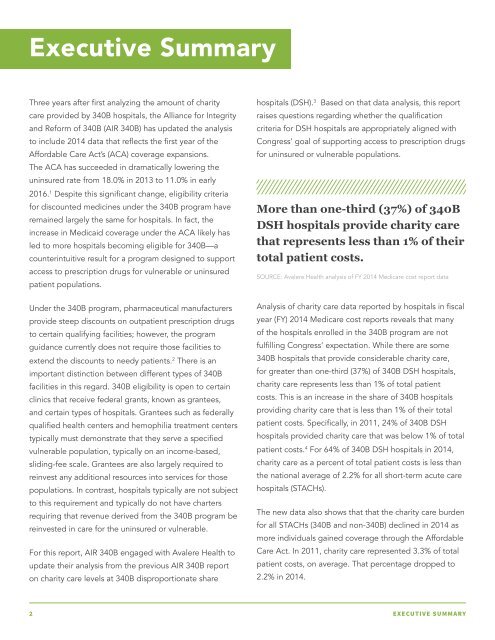BENEFITING HOSPITALS NOT PATIENTS
1rI7CJA
1rI7CJA
You also want an ePaper? Increase the reach of your titles
YUMPU automatically turns print PDFs into web optimized ePapers that Google loves.
Executive Summary<br />
Three years after first analyzing the amount of charity<br />
care provided by 340B hospitals, the Alliance for Integrity<br />
and Reform of 340B (AIR 340B) has updated the analysis<br />
to include 2014 data that reflects the first year of the<br />
Affordable Care Act’s (ACA) coverage expansions.<br />
The ACA has succeeded in dramatically lowering the<br />
uninsured rate from 18.0% in 2013 to 11.0% in early<br />
2016. 1 Despite this significant change, eligibility criteria<br />
for discounted medicines under the 340B program have<br />
remained largely the same for hospitals. In fact, the<br />
increase in Medicaid coverage under the ACA likely has<br />
led to more hospitals becoming eligible for 340B—a<br />
counterintuitive result for a program designed to support<br />
access to prescription drugs for vulnerable or uninsured<br />
patient populations.<br />
Under the 340B program, pharmaceutical manufacturers<br />
provide steep discounts on outpatient prescription drugs<br />
to certain qualifying facilities; however, the program<br />
guidance currently does not require those facilities to<br />
extend the discounts to needy patients. 2 There is an<br />
important distinction between different types of 340B<br />
facilities in this regard. 340B eligibility is open to certain<br />
clinics that receive federal grants, known as grantees,<br />
and certain types of hospitals. Grantees such as federally<br />
qualified health centers and hemophilia treatment centers<br />
typically must demonstrate that they serve a specified<br />
vulnerable population, typically on an income-based,<br />
sliding-fee scale. Grantees are also largely required to<br />
reinvest any additional resources into services for those<br />
populations. In contrast, hospitals typically are not subject<br />
to this requirement and typically do not have charters<br />
requiring that revenue derived from the 340B program be<br />
reinvested in care for the uninsured or vulnerable.<br />
For this report, AIR 340B engaged with Avalere Health to<br />
update their analysis from the previous AIR 340B report<br />
on charity care levels at 340B disproportionate share<br />
hospitals (DSH). 3 Based on that data analysis, this report<br />
raises questions regarding whether the qualification<br />
criteria for DSH hospitals are appropriately aligned with<br />
Congress’ goal of supporting access to prescription drugs<br />
for uninsured or vulnerable populations.<br />
More than one-third (37%) of 340B<br />
DSH hospitals provide charity care<br />
that represents less than 1% of their<br />
total patient costs.<br />
SOURCE: Avalere Health analysis of FY 2014 Medicare cost report data<br />
Analysis of charity care data reported by hospitals in fiscal<br />
year (FY) 2014 Medicare cost reports reveals that many<br />
of the hospitals enrolled in the 340B program are not<br />
fulfilling Congress’ expectation. While there are some<br />
340B hospitals that provide considerable charity care,<br />
for greater than one-third (37%) of 340B DSH hospitals,<br />
charity care represents less than 1% of total patient<br />
costs. This is an increase in the share of 340B hospitals<br />
providing charity care that is less than 1% of their total<br />
patient costs. Specifically, in 2011, 24% of 340B DSH<br />
hospitals provided charity care that was below 1% of total<br />
patient costs. 4 For 64% of 340B DSH hospitals in 2014,<br />
charity care as a percent of total patient costs is less than<br />
the national average of 2.2% for all short-term acute care<br />
hospitals (STACHs).<br />
The new data also shows that that the charity care burden<br />
for all STACHs (340B and non-340B) declined in 2014 as<br />
more individuals gained coverage through the Affordable<br />
Care Act. In 2011, charity care represented 3.3% of total<br />
patient costs, on average. That percentage dropped to<br />
2.2% in 2014.<br />
2 EXECUTIVE SUMMARY


